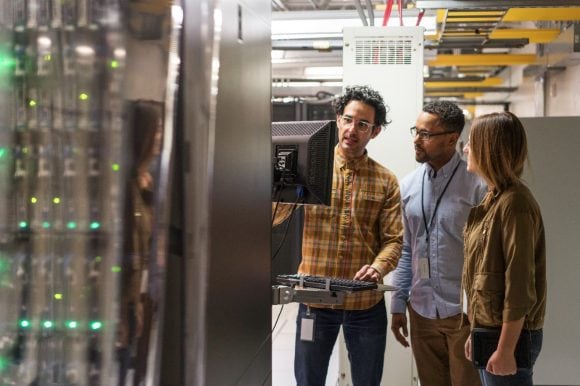Data centers
Data centers are growing rapidly across the world. How can we manage their sustainability impacts?

![]()
header.search.error
Data centers are growing rapidly across the world. How can we manage their sustainability impacts?


Natalie Sinha
Head of Sustainability, Infrastructure

Matt Edgely
Chief Operating Officer at Datum Datacenters
Natalie Sinha, Head of Sustainability for Infrastructure sat down with Matt Edgely, COO at Datum Datacentres to discuss data centers: how they work and the sector’s evolution in the coming years.
How would you describe what a data center is, and why are they important?
The demand for digital services is growing rapidly. Governments around the world have recognized the essentiality of high-speed internet and digital infrastructure. As a result, global data demand is expected to nearly triple in the five-year period to 2027 from 3.4 TB in 2022 to 9.7 TB in 2027.
In order to accommodate the growth in data demand, we need more data centers. Data centers are purpose-built facilities to house computing infrastructure. They provide the core infrastructure that underpins all digital activity across government, business and community.
What does Datum do, and what’s your vision?
Datum Datacentres operates network of environmentally efficient, carrier neutral data centers. Our platform supports digital transformation, and we offer flexible contracts, in-house support and service management. Here at Datum, our vision is to continue to build our network of regional data centers in strategic locations.
Data centers often get a lot of negative publicity around their environmental impacts. Why do you think that is?
Data centers are generally seen as environmental monsters. That’s because they now account for between 1-1.5%1 of global electricity use, and this is expected to increase as more and more data centers come online. We need environmental policies to keep pace with data center growth to ensure that energy efficiency and the potential negative sustainability impacts of data centers are being managed well.
Tell us more about the biggest sustainability impacts of a data center.
Data centers need power and cooling 24/7, 365. Our clients’ equipment needs to be running all the time, and this generates lots of heat that needs removing. We seek to optimize the temperature inside the data center, and so our biggest impacts are energy consumption and heat emissions. We have different types of cooling systems: some cooling systems, called adiabatic systems, use a lot of water. Other cooling systems use gas. We need backup power for resiliency as well, which requires a lot of fuel. In the past, we used diesel for our back up generators, but we are switching this to hydrotreated vegetable oil which is a lower emission fuel.
If energy use is your biggest impact, how do you work out how much energy you’re using?
We’ve got meters everywhere! We have meters on every single fuse board, piece of equipment, and the mains power for the site. We also monitor where the power is going, so we can work out the efficiency of the different types of equipment, and how much power each customer is using.
How do you measure energy efficiency?
The data center industry uses power usage efficiency (PUE) to measure energy efficiency. PUE is expressed as a ratio, on a scale of 1 to 3, with 1 being considered the most energy efficient, and 3 being considered the least energy efficient. At Datum, we target a PUE of 1.2. This means we’re targeting high levels of energy efficiency and using equipment with lower energy losses.
What commercial value does sustainability have for a data center?
Sustainability has huge commercial value for data centers. A lower PUE and higher energy efficiency is an all-round win, because it means there is less energy used, and less wasted. So, you can be more competitive on pricing for the end user, you charge the customer less, and margins are improved. In the UK, if you improve your energy efficiency and PUE year-on-year, you can get discounts of up to 90% on your energy bill under the Climate Change Agreement (CCA) for data centers.
How do you see the sector evolving over the coming years? Do you believe the hype around AI?
The data center industry is evolving rapidly. AI has brought data centers into the mainstream, and we’re under the spotlight. AI will bring a lot of growth, and new challenges. Access to power is, and will continue to be, the main challenge within the industry. Cooling technologies will develop and change. We’ll probably see an increase in data centers using hybrid cooling technologies.
And, as the industry grows, we’ll definitely see an increasing focus on energy efficiency for data centers. The industry will need to innovate around sustainability as well. One area to keep an eye on is how the industry uses the heat generated from data centers. As data centers grow, there will be more heat generated by them. This heat can be reused and distributed through community heat networks. It could even be used to heat greenhouses and grow fruit and vegetables year-round.
Want more insights?
Subscribe to receive the latest private markets perspectives and insights across all sectors directly to your inbox.